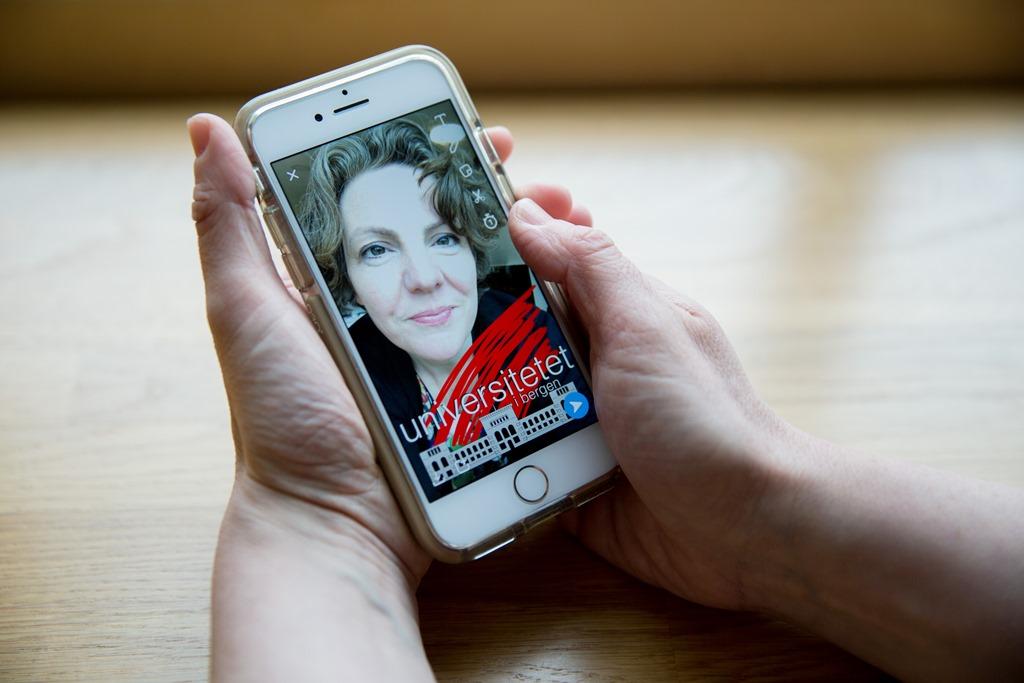Rewarded for her Snapchat Research Stories
Professor Jill Walker Rettberg studies how humans use technology and what it means to us as a culture.

Hovedinnhold
“As a professor of Digital Culture, I study how humans meet technology. I am most concerned with the aesthetic side, like how we create stories and art online. I find it equally important to look at everyday expressions most people create on social media as studying online art and electronic literature”, Jill Walker Rettberg explains.
How people tell stories online
Rettberg has a particular interest in personal narratives. She does research on digital self-representations viewed from three angles; visual, like selfies, written, as in blogs, and quantitative, the way we represent ourselves through numbers, maps, graphs and visualizations.
“People have throughout all ages presented themselves in various ways. This is not about the technology itself but about people's need to understand themselves and their role in the world. We create different self-representations through the different media we use and this says a lot about the society we live in and contribute to”, she says.
Rettberg makes a point of the importance of being aware of how different technology controls the way we act. What stories about life do we want to tell? What control do we want over the stories created about us? What do the logs on our smartphones tell us about ourselves and what do they not tell us about?
“Log entries of food and exercise are examples of this challenge. Who really controls your body when everything you do and eat is logged? Who defines the norm for bodies?” she asks.
A knowledge sharing pioneer
Rettberg is interested in all sorts of digital media and is often the first one to try out new stuff. Studying blogging she became the first Norwegian research blogger and has been sharing her research on jilltxt.net since 2000.
In 2016 while studying the use of Snapchat she also started to share her research through the media, making Snapchat Research Stories. For this pioneering use of Snapchat she was recently awarded the John Lovas Award, an award given to academics sharing knowledge on social media. She became the first to win the award for something other than blogging.
“Snapchat storytelling is a new form of storytelling that is enormously important for many people. One third of all Norwegians above 18 are on Snapchat every day, but it’s not much discussed how it affects the public debate”, Rettberg says, a discussion she is soon about to take into a non-digital platform.
Rettberg will spend the autumn semester in Boston as a visiting scholar at Massachusetts Institute of Technology (MIT) and their Department of Comparative Media Studies.
“I’m really excited about that, it will be a very inspiring place for me to do research, and I have a very exciting project I plan to do while staying there. I have been asked to write a book about Snapchat by the publisher Polity who published my book about blogging, to which I of course answered yes”.
The new forms of visual technology
Rettberg’s latest interest is machine vision and new forms of visual technology.
“Machine vision is being very rapidly developed, from drones to facial recognition. There is not much research on how we use it or how it affects our culture, though”, she claims.
Biometrics used in Snapchat lenses is a form of machine vision, otherwise used in surveillance, to control and identify people. Today it has become something we play with. To Rettberg this is an exciting change, but she is also aware of the dangers of the speed of technological development.
“It is important not to only develop technology that is possible to make, but to make technology that is good for us as a society. It is not enough to understand how technology works, we must also understand what kind of technology people want and need. This is where the humanities need to be involved. This is where I intend to be involved”.



